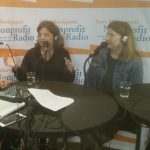Board relations. Fundraising. Volunteer management. Prospect research. Legal compliance. Accounting. Finance. Investments. Donor relations. Public relations. Marketing. Technology. Social media.
Every nonprofit struggles with these issues. Big nonprofits hire experts. The other 95% listen to Tony Martignetti Nonprofit Radio. Trusted experts and leading thinkers join me each week to tackle the tough issues. If you have big dreams but a small budget, you have a home at Tony Martignetti Nonprofit Radio.
View Full Transcript
Transcript for 531_tony_martignetti_nonprofit_radio_20210329.mp3
Processed on: 2021-03-27T13:44:35.519Z
S3 bucket containing transcription results: transcript.results
Link to bucket: s3.console.aws.amazon.com/s3/buckets/transcript.results
Path to JSON: 2021…03…531_tony_martignetti_nonprofit_radio_20210329.mp3.787609194.json
Path to text: transcripts/2021/03/531_tony_martignetti_nonprofit_radio_20210329.txt
[00:02:22.04] spk_1:
Hello and welcome to tony-martignetti non profit radio big non profit ideas for the other 95%. I’m your aptly named host of your favorite abdominal podcast. Oh, I’m glad you’re with me. I’d be thrown into zero Estonia if I had to mouth the words you missed this week’s show Cure Communications Gaffes. Our 21 NTC coverage begins by explaining what to do after you put the wrong gala date in your email or send a letter to the wrong segment. Might an intentional mistake improve your open rate? Our panel is Julie’s. If ST Claire Thomas and Shefali Row, all from Sancti Communications and talking Mental Health in your workplace, also from 21 NTC, Dan Burstein helps you avoid a different gaffe, saying the wrong things when faced with challenging behaviors or mental health disclosures, he’s got easy to follow strategies. Dan is founder of M H. Mediate on tony State, too. How are you doing? We’re sponsored by turn to communications, PR and content for nonprofits, your story is their mission. Turn hyphen two dot c o. Here is a cure. Communications gaffes. Welcome to tony-martignetti non profit radio coverage of 21 NTC That’s the 2021 nonprofit technology Conference. We’re sponsored at 21 NTC by turn to communications. Turn hyphen. Two dot c o. My guests at this session are Julie’s. If ST Claire Thomas and Shefali Row. They’re all with Sancti Communications. Julie is vice president of account and Strategic Services. Claire is copy director, and Shefali is senior copywriter. Welcome, Julie.
[00:02:22.57] spk_2:
Thanks for having us.
[00:02:23.81] spk_3:
Welcome to be here.
[00:02:32.24] spk_1:
So, uh, let’s see. So does everybody work for Julie? And then then And then Claire reports The Shefali is It doesn’t work like that. I’m sure it’s a very collegial place. Thank you. Community were totally lateral. Totally flat. Everybody gets the same pay. Everybody is exactly the same
[00:02:54.44] spk_2:
way. We’re really collaborative agency, but I work more on our strategic side of things. And Claire and Shefali are two of our genius copywriters who manage our clients messaging.
[00:03:37.34] spk_1:
Okay, I think it’s important to flush this out. So give folks a feel for swanky communications because they might be working with you someday. Your workshop topic is my bad to all. Good. How to repair a mistake in donor communications. So, like if you dropped an email with a mistake in it, or you sent out an email about the gala, and it has the wrong date or the wrong time. That’s that’s That’s a particularly egregious one. We would think we would catch that in copyrighting. So, um, Shefali, let’s start with you. How does these things happen? First of all, like suppose that example? Wrong time in the gala invitation. How could that How could that possibly happen when we have multiple eyes on projects on communications?
[00:04:14.34] spk_4:
Yeah, you would think that it wouldn’t, but sometimes it just misses all sets of five. I actually gave this example, even in the conference, but I used to be a journalist, and I used to be at the news desk copy editing and one day on the front page in a headline. The word public was missing an L. And that just went out the next day. And, um, the good news is that we have a system we have, like, strategies in place where we kind of make those mistakes work for us. Which is really what our workshop was about.
[00:04:18.19] spk_1:
Yeah. I mean, you could have some fun. I don’t know. Pubic might be tough. to have fun you can have fun
[00:04:22.29] spk_4:
with
[00:04:36.74] spk_1:
without getting carried away. I mean, I think making light of a mistake, a gaffe. I use that all the time. I mean, you’re suffering with a lackluster host, so don’t be surprised if this comes up three or four times in a half an hour. Um, like the banging? I don’t know. You know, I have you here that banging
[00:04:42.14] spk_3:
a
[00:05:03.04] spk_1:
little. Okay, it’s It’s a hammer. There’s guys working on my stairs. You might hear vacuuming because they’re very fastidious about cleaning up. You might hear some, uh, sawing drill drill. Uh, circular saw type work. Um, not that that’s a gaffe, but, you know, it’s background noise. We got to call it out. If I can’t hide it, I’m gonna flaunt it, so well. Shit. I gotta ask, What did the paper do with, uh, public to
[00:05:20.94] spk_4:
pubic? And then we printed into the collection the next day. That’s all you can really do. That’s not the fun way. I mean, it’s not a fun where it was pretty upset about it, but we have actually had fun with some of our mistakes in the bus. Right?
[00:05:24.44] spk_1:
Okay. Who wants to share a mistake that, uh, so
[00:05:27.40] spk_3:
one of them One of them was in the footer. You know of an email and, you know, these things go out all the time, and and everybody is real careful about the
[00:05:36.00] spk_4:
content of the email, and And
[00:05:46.34] spk_3:
was the subject line perfect? And you kind of forget to be as careful about the footer and in the footer to the donors. It said eight cents of every dollar goes to programs services.
[00:05:51.34] spk_1:
Okay. Yeah.
[00:05:52.64] spk_3:
Now, most people already wouldn’t even see
[00:05:55.27] spk_1:
that Most people are going to look at the footer,
[00:07:01.34] spk_3:
right? This and this is an animal shelter. So? So when when it was caught, we were like, Okay, so we’re So what we did was we said, Okay, let’s let’s send it up. But let’s stay in character for how the donors know us. And we we have with this with this, um, animal shelter. We have a really fun, friendly voice. And so we sent out a correction email, and we used it to educate donors on what the truth is. And what we said was forgive us if you are, forgive us for our mistake. Um and we try. We’re pause P a w positively horrified. We made this mistake because the truth is it’s 82 cents of your dollar that goes to programs services, and we’re really proud of that. And then we talked about how we care for donor services. But we kept the really used pictures of cute puppies and kittens and, you know, it was all friendly and fun, and it was a good chance to educate the donors on what the actual You know how the organization uses donor resources. And,
[00:07:25.04] spk_2:
of course, the silver lining on that example and everything else is that when you do have an effective apology like that, um, you can have extraordinary engagement with your donors. So for that example that Claire just shared, we had over 50% open rate and almost a 5% click through rate, which is more than three times as high on both metrics as as you might hope to see.
[00:07:39.04] spk_1:
Yeah, Julie, I was going to go to you. Uh, so it sounds like the first thing you should do when you discover one of these gaffes is don’t panic,
[00:07:40.84] spk_2:
never panic. Panicking definitely does not help
[00:07:43.58] spk_1:
you accomplish your compound, right, you’ll send the wrong thing. You won’t think it through. You’ll blow the one chance you have to really fix it well, so keep your head on.
[00:08:35.44] spk_2:
Panicking definitely doesn’t help in any environment, I will say before, you know before you get there. It’s definitely worthwhile to have a comprehensive QA process. Um, and quality assurance process. Make sure that you’re going through steps to try to avoid the mistakes in the first place. But then, yeah, once the mistake happens, because no matter how good your quality assurance process is, mistakes will happen. Um, so when something does happen to be able to, like you said, don’t panic, figure out what was the mistake? What was what type of mistake was it? Is there an opportunity there? There might be a silver lining. There might be an opportunity. And how can you? How can you apologize in the most effective way? Or turn the mistake into make some lemonade from that lemon and really find a good silver lining there?
[00:08:58.34] spk_1:
What if someone is screaming at you? Maybe it’s a board member who just got the email. Maybe it’s the CEO. Whoever someone senior to you is furious about the mistake. Yeah, about them. Yeah, not about Not about what you’re wearing that day. But yeah,
[00:09:03.86] spk_3:
I’m just because the other problem is when the donor picks up the phone and starts to screen with you, right?
[00:09:20.34] spk_1:
Okay. It could be a donor, but I was trying to manage in the office first, but that’s a good one. Clear. We’ll get to. We’ll do that later. The secondary. The secondary market. Yeah, the other constituents. But how about right in your office? Uh, you know, a CEO or board member? Well, we’ll consider board members insiders for purposes of our conversation. What do you do there? Furious.
[00:09:49.54] spk_3:
Yeah. Yeah. And the first thing to do is to say, this is this isn’t all bad. There’s There’s probably an opportunity here. And we had a whole section on opportunities. Every every one of the case studies that we presented and the our speed round where people were talking about all these are the mistakes they made, you know, we talk about Well, there’s an opportunity there, like shuffle. You had some great ideas about opportunities.
[00:10:22.94] spk_4:
Yeah, and I mean, the first question you asked that the step was How does this happen? You know what I mean? Like, how do these mistakes happen? And they happen because there are human people at the other end of that happens like we all make mistakes. And sometimes the donor wants nothing more than to know that a person is at the other end of these communications. And that’s your opportunity right there to say sorry. Build a connection to make, like, some sort of personal, heartfelt apology. Um, and then you have a lasting connection with the donor.
[00:10:51.04] spk_1:
Claire, let me continue with you where we’ve got a furious supervisor here. Doesn’t it help to just also say, I’m sorry? I mean, I know, I know. I know. I made a mistake without trying to deflect or, you know, just even if it’s not 100% your mistake. Like if two other people read the copy also, but but the CEO is in your office in the moment. Oh, yeah. You just say I know, I know. We messed it up or I’m sorry. You know, I mean, just right, well,
[00:10:56.17] spk_3:
and and it is, you’re you’re absolutely right. But then there’s the other. The other mistake that you just alluded to when it was completely out of your control. Julie, talk about what happened with the USPS this year.
[00:11:30.54] spk_2:
Oh, my goodness. And so this is, you know, there are definitely issues that are outside of our control, right? So, you know there was for people who use Blackboard Online Express there was one year that it stopped taking donations on giving Tuesday. There was the black pod data breach last spring and summer. Gmail started hard bouncing in the middle of December this past year. And then, of course, in direct mail, USPS had delays and we had some of our clients were sending out holiday fundraising appeals at the very beginning of December. But then the seeds weren’t even received until the beginning of January. So if you’re mailing that,
[00:11:54.84] spk_3:
you think Yeah, I mean, there’s There’s a pissed off CEO pissed off client pissed off everybody that people didn’t The donors didn’t get the asks.
[00:11:58.54] spk_1:
Yeah, it’s
[00:13:06.94] spk_2:
outside. It’s outside of your control. But there are ways to make that into an opportunity. We had one client. They had sent out a mailing that talked about a December 31st, matching gift deadline, but people didn’t receive the mailings. Um, it bombed. And so we have brainstormed with them. What can we do to figure out a way around this? And we ended up doing an email campaign in early January that effectively said, We understand there were delays with the post service. We know that you may not have received our appeal letter. We would like to tell you that even though it said that the matching gift deadline was on December 31st we talked to the matching gift donor, and we’ve been able to extend it. Please make your contribution now, and so you know it’s not going to necessarily completely counter active. You know that’s not our mistake, but it’s not going to completely counteract that problem. But you can still look for a silver lining. You can still try to connect with the donors, show them that you are a human, show them that you’re all partners together for the mission, um, and then bring them back on board for for the mission.
[00:13:26.44] spk_1:
Claire, you you seem to be the one who raises the good hypotheticals. Alright, let’s let’s go outside now. I suppose it is a donor on the phone, so it’s not. It’s not a supervisor, but now it’s a donor. You know, maybe it’s maybe they’re the ones who maybe they’re the challenge donors who December 31st, you know, in January 3rd, they got the they got the challenging male or whatever it is, you have an upset donor or a very upset volunteer. How do you manage that?
[00:15:20.44] spk_3:
Well, first of all, remember that the fact that someone has picked up the phone and called you you have a dedicated donor on the other end of the line. This is a person who cared enough, cared enough about the work that you’re doing and is invested enough in the mission to pick up the phone and complain. So you’ve got someone on the phone who really cares, and then you kind of follow some basic steps. Remember feelings before solutions? Let them vent. Let them say whatever it is that made them angry and listen to it and be sympathetic and listen for opportunities to connect and then solve the problem. Sometimes it’s that it’s that the donor says, Well, I only wanted to be mailed once a year, and this is the third appeal I’ve gotten this year, and so you know you have a chance to draw them into a conversation and get them talking about why they care about the organization’s work, why this mission matters to them. Once they start talking about why they care, they usually talk themselves into wanting to give. I’ve been in the situation where I’ve been the person talking to the donor that was angry and letting them talk and then finding a way to, like, say, Well, that’s a really good point and I think we can We can address that mistake and then upgrading the donor getting them. That’s actually how I started in fundraising. I was. I was asked to call donors who were angry, find out what the problem was and and then just these were people who had pledged money, and we’re going to pay it off. I raised all the money they had pledged just by listening to them just by solving little problems that they had really small. Um and then they ended up being very dedicated, the organization, because again it’s what you’ve always said is that human human, you know, these are people on both sides of the equation. Philanthropy is, of course, the most human of acts.
[00:15:40.74] spk_1:
You all know the service recovery paradox.
[00:15:44.84] spk_3:
No,
[00:15:46.44] spk_1:
really, I haven’t. We
[00:15:49.33] spk_3:
do that. Pardon me? My suspicion that we actually do that.
[00:16:07.54] spk_1:
Well, yeah, you’re you. You could very well be a part of it, but, um, it’s bona fide. There’s research. The service recovery paradox is that someone for whom a mistake occurs and and has that mistake satisfactorily corrected will be more connected to the brand. I think I’ve seen it more on the commercial side will be more connected to the brand than someone for whom a mistake never occurred.
[00:16:20.14] spk_3:
Yeah,
[00:16:21.62] spk_1:
actually, you’re describing Claire like your clarity talking about upgrading people who were upset.
[00:16:28.24] spk_2:
There are a lot of psyche communications. We were founded by sinking pursuant. Um, back in the late seventies. And there are a lot of myths around Spanky Pearlington. Um, and many of them are not verified.
[00:16:42.65] spk_1:
Uh, thank you, man or a woman or
[00:16:44.76] spk_3:
she is a woman.
[00:16:49.84] spk_2:
Um, I think he was a nickname for Selma. Um, apparently, maybe that’s the new thing that we can learn for today. Um,
[00:16:54.61] spk_1:
I think
[00:16:55.60] spk_3:
I
[00:17:24.44] spk_2:
know so So There are a lot of a lot of myths around her in the industry, but one, and I have no idea if this is true. But I have been told that she used to plant mistakes and direct mail letters because there was an increased increased responses or an increased response rate or an increased giving. If there was a mistake in the letter, people would actually right back, correct it and send in their check while they were at it.
[00:17:26.56] spk_1:
That’s brilliant.
[00:17:27.84] spk_3:
It’s brilliant,
[00:17:43.84] spk_1:
right? They love you enough to point out like Claire was saying, they love you enough to point out your mistake. But then they might feel bad about not including a check. So you’re you’re you’re helping them get over the hurdle of, uh, whether to reply, you’re giving them a giving them an even better reason to reply. And by the way, they feel bad. If they if they only complain so they’ll give you money too well.
[00:18:05.94] spk_3:
And we writers like to believe that once somebody has noticed some kind of little mistake, they start reading for other mistakes, and then they actually get hooked into the message. Those of us who spend all our time crafting those messages. It’s our chance to hook them.
[00:18:13.44] spk_1:
Shefali, do you do you deliberately? Have you ever deliberately honest Now have you any deliberate mistake in?
[00:18:18.61] spk_4:
I have to say I’m having this conversation. I’m already thinking of, like subject lines that maybe you have a mistake, but not super obvious. But it would get people to just open the email.
[00:18:30.64] spk_1:
Wait, wait, I want to flush this out. We’re getting good advice. This is the stuff I love. A nonprofit radio. Actionable, actionable advice. What way?
[00:18:53.54] spk_4:
What’s an example? For example, I’m just thinking, What if the subject line just had somebody else’s name and you click on it? Because you think OK, this person made a mistake? That’s not my name. And then you open it and says, Just getting Of course we know you’re tell me because you are one of our most dedicated supporters,
[00:19:06.84] spk_1:
Okay, but they think they’re being voyeuristic by opening it up. It’s made for somebody else. I definitely want to check that out more so than I would read my own. The problem with
[00:19:09.64] spk_2:
tony that that that will be great with the donors. It may not be so great with that CEO that comes into your office yelling.
[00:19:24.34] spk_1:
Well, I should get approval in advance and say, Look, I want to want to test it. I want to test it exactly like we’re going to send 1000 that are that are misnamed than 1000 that are correctly named And, uh, let’s see. Let’s see which one pulls better. Which one clicks through better. You want to
[00:19:34.69] spk_3:
share one more?
[00:19:36.33] spk_1:
I have these copywriter minds think it’s amazing. Anything else occur to you while we’re talking?
[00:19:42.54] spk_4:
No, that’s it. I mean, new campaign idea in two minutes. I’m pretty happy with
[00:20:13.64] spk_1:
that. Yeah, right. Okay, well, we’re 17 minutes in, so try to try to up your game a little bit. Were already. You’re only one idea in 17 minutes. We’ve got to do a little better than that. Um all right, what else should we talk about? The crisis communications management is this This is this is no, I mean, that’s a crisis, but we’re now we’re moving to organizational crisis. Where the where the local paper headline and it’s not good. Who? Julie, you got You got a first bit of advice for that.
[00:22:10.54] spk_2:
Um so I think we we go back to where you started with before, which is always start with. Don’t panic. Um, for many of the organizations that we that we work with, one of the first things that we do is we talk to them about what is the rapid response plan? Um, it applies to if there’s a hurricane that impacts your services or if there’s a political situation that impacts your services or if there’s something in terms of internal politics where there’s something that is going to impact your reputation and you have that that rapid response plan. And it’s a question of, you know, we’ve given whole other talks about this and that it’s a whole other topic of conversation, but it is. It is really important, right? If you have the plan going in that you can deal with whatever the issues are, so you say Okay, who are the decision makers at the organization? What is the chain of command? Who are the people who we need to gather at the organization to figure out whether or not we respond? If we respond, what channels do we respond in what is the messaging of that response, right? And so you know that that really does have to depend on what is the situation. And in some some issues you don’t some problems, whether it’s a mistake internally, a mistaken communication or a one of these kind of rapid response publicity, something some situations will not require a response, and others do. And so it’s a question of what is the message? Is it something where, you know, if you actually do something really offensive, who is the right person to say something? Is it the executive director? Is it the chair of the board? Um, so so is it somebody who is a trusted individual who is the right signer for it? What is the right message? You know, we do. We do often. I will say, use humor when we are crafting an apology. Claire Claire talked about that example of Please forgive us from an animal shelter. You’re not going to do that if it’s something really offensive, you
[00:22:22.60] spk_1:
don’t want to. Yeah,
[00:22:24.30] spk_4:
I
[00:22:30.54] spk_2:
mean, you never know, but you want to be very human. Talk about it. Ideally, you want to be real explain. Here’s the situation and and have a very real genuine apology. What?
[00:22:56.84] spk_1:
Okay, what if at the outset, you don’t You don’t have enough facts. I mean, can you Can you come out and say we can’t comment right now? You know, we’re still looking into whatever the situation is, and we don’t want to say anything inappropriate. So give us 24 hours or something like that. Well,
[00:23:34.54] spk_3:
and committing to transparency in that process, I think is going to go a long way to saying we’re still figuring this out. We want you to know we’re on it. Were These are the steps we’ve already taken. Here’s a step. There is the next step we’re taking, and we’re going to tell you what’s going on. You know, you’re going to hear about this. Um, and just just to reassure them anytime you’re you’re dealing with somebody you’re dealing with donor group, they’ve given you their money. This is this is an act of trust. You have to you have to work to keep that trust, um, to make sure it’s, you know, earned. So you don’t want to lose that,
[00:23:49.04] spk_2:
and transparency is important. But you’re also then messaging them and saying to them as a donor. You are. You are our partner in executing our mission. You are part of the organization. We owe you an explanation. And we need you to help us get through this. We need you to continue to support, um, you know, shelter, animals, homeless youth, whatever the population is that you are providing services to you, our our partner in supporting this mission. And we need you to stand with us.
[00:24:11.94] spk_4:
Yeah, and the more authentic and personal it is, it’s also it’s more of its transparency. But it’s also assurance that not just like it’s not just we have your best interest isn’t just that hot, but it’s also you’re in the know about what’s happening in the organization. Like Julie said, you’re a partner
[00:25:33.54] spk_1:
building on that trust that Claire was talking about. Yeah. Yeah, right. You have that trust in the bank you don’t wanna you don’t wanna exploit it, uh, and squander it, which, you know, conflicting messaging will do. I think too much delay. Depending on the situation, you know, too much delay. Then the story gets ahead of you, and I’m envisioning something really bad, you know, and then somebody else controls the narrative, and you’ve You’ve lost your opportunity. You know, those those things are bad. And that’s that’s a squandering of good faith, squandering of trust. All right, well, that’s that. That’s the trust to that Claire you talked about when we were talking about the gaffes. You know, people love you so much that they’re going to let you know that you made a mistake. Those are those are the most concerned, Like most invested people, the ones who don’t care, we’re gonna write off like, uh, another. Another problem with these people, you know, something like that. But the ones who really care, we’re gonna say, How could they let this happen? Do they know? You know? So, yeah, they’re invested their invested. All right. Um, what else are we talking about? We got a couple more minutes. We don’t have to wrap up whatever we covered yet.
[00:25:38.94] spk_3:
Well, one of the fun things we talked about not fun at all. It was how to apologize appropriately.
[00:25:45.24] spk_1:
Okay, well, you gave a good example of the animal shelter. Were,
[00:26:02.84] spk_3:
But if it’s offensive, what we’ve all noticed in, you know, in our media consumption in the last couple of years. Is all of these people, uh, providing apologies? You know, apologies.
[00:26:25.34] spk_1:
Backhanded apologies, if backhanded apology. If anyone was offended. Exactly, I didn’t intend it. And I regret that they’re offended. So it’s like it’s like their fault. It’s your fault for being offended, right? I regret that you’re offended, you know? All right, talking about her one. Horrible. Yeah,
[00:26:36.14] spk_3:
it’s horrible. And we actually said, Be sure if someone if someone said something offensive, be sure they say I offended. And I apologize.
[00:26:37.31] spk_1:
We should follow, you know, making human. There’s a human behind this apology. Not it wasn’t written by a
[00:26:43.58] spk_4:
robot. You know, it’s not like a template apology. Yeah, 100. An apology
[00:26:50.44] spk_1:
if anyone was offended. I’m sorry that they are regret that they are people who won’t even say step. Probably won’t even say sorry. I regret that. It’s unfortunate that you are
[00:27:01.19] spk_3:
all
[00:27:16.04] spk_1:
right. All right. What else you want to, um Let’s see. Anybody who wants to take us out with, uh, parting parting advice for the Let’s stick with the Gaff. I like that. That was the most animated part. The somebody take us out with good gaffe advice.
[00:27:19.24] spk_3:
Well, I’ll tell you one of the things we had fun coming up with Shefali and I, um, included. We gave a little bit of conference swag in some some checklists and things that people
[00:27:31.03] spk_1:
can take.
[00:28:21.14] spk_3:
And we also provided a little freebie five subject lines to try if you made a mistake. So this is how this is how to get somebody to open your email apology. And so we came up with we came up with. Well, this is awkward. Um, let’s see if we can get our apology right. You deserve our best. You didn’t get it. Can you forgive us? Name of donor and then my favorite. I think this is shit follies. Um, the email you were actually supposed to get name. Okay, So just kind of helping people out. We have. We have unfortunate reasons. Were knowing that all of those emails are successful. Um, so a
[00:28:35.84] spk_1:
lot of communications is gonna be a lot of mistakes. I mean, it’s going to happen. It’s humans. You don’t you don’t strive for them. Obviously you strive not to like Julie was saying, but but with QA. But it’s going to happen now. What about this? I don’t like I don’t like teasing nonprofit radio listeners, and then they don’t get anything. What about this checklist you mentioned? So
[00:29:03.24] spk_2:
those five subject lines along with a variety of other things, including some of the most common QA mistakes to watch for, um, at sinking dot com slash ntc 21 you can download a pdf that has whole bunch of good checklist for both avoiding mistakes. And then what to do if you made a mistake.
[00:29:07.44] spk_1:
Okay,
[00:29:13.54] spk_2:
so that was Thank you. Slash And so sink e ink dot com slash ntc 21.
[00:29:20.54] spk_1:
Got it and sank is s a N k y. Thank you dot com slash ntc 21. All
[00:29:24.33] spk_3:
right.
[00:29:43.34] spk_1:
Thank you. Think as opposed to what I said, which was Thank you. Thank you, Link. All right, Nobody talked. Now nobody talked. Thank e ink dot com slash ntc 21 You betcha. Thank you. All right. I don’t like cold, madam. Non profit your listeners. Alright, Good. So they can get the resource there. We’re gonna leave it there. Julie’s if sent Vice President of Accounts and Strategic Services. Claire Thomas, Copy Director Shefali Rao, senior copywriter all at Sancti Communications. Thank you very much. Wonderful.
[00:30:01.56] spk_3:
Thank you so much Fun.
[00:32:49.14] spk_1:
Real pleasure. I enjoyed it. And thank you for being with tony-martignetti non profit radio coverage of 21 NTC 2021 Nonprofit Technology Conference where we are sponsored by We should be sponsored by sank Communication with all these shout outs I’m giving, but we’re not. We’re sponsored by turn to communications sank e ink dot No, not spanking dot com Turn to communication. Turn hyphen two dot c o responsible. I turn to communications Turn hyphen two dot c o thanks to each of you. Thank you very much. It’s time for a break. Turn to communications relationships turn to has the relationships with media outlets, journalists, even bloggers podcasters like me they have the outlets to get you placed When there’s a reason for you to be in the news. There’s some news hook that they can grab and they can talk to the Chronicle of Philanthropy, CBS Market Watch, et cetera. They’ve got the existing relationships and they’ll leverage them to your advantage because you’re their client. You get in the media, turn to communications. Turn hyphen two dot c o It’s time for Tony. Take two. How are you? How are you doing? Have you had a vaccine? How’s your family doing? Your family been vaccinated? I’m interested. I’m interested in how listeners are doing. I sent this out asking folks who get the insider alert our weekly insider alert. And I got a bunch of responses back. People. People told me how they’re doing. Tell me what’s going on, How they’ve been what? What It’s like, uh, planning to go back to work, etcetera. So I turned it to listeners. That’s you. How are you doing? How’s your family? Let me know. You can use my email. Here it is. It’s not gonna be able to use it and give it to you tony at tony-martignetti dot com. Tony at tony-martignetti dot com Let me know how you are That is Tony’s Take two. We’ve got boo koo, but loads more time for nonprofit radio. Here is talking mental health in your workplace. Welcome to tony-martignetti non profit radio coverage of 21 NTC, The 2021 nonprofit Technology Conference. We’re sponsored at 21 NTC by turn to communications turn hyphen two dot c o. My guest now is Dan Burstein. He is founder at M H. Mediate. Dan. Welcome to our coverage of 21 NTC.
[00:32:59.94] spk_0:
Thank you very much for having me.
[00:33:15.94] spk_1:
Pleasure. Absolute pleasure. We’re talking about something that’s important. That’s not talked about enough. Your session is talking mental health in a virtual workplace. There’s there’s stigma around mental health. Is it? Is it Is it worse now in a
[00:35:38.34] spk_0:
virtual world? Um, I would say that, and I’ll just say, I’ll just say that, you know, my background is I’m a mediator and I do work to help people talk about mental health. But I also personally live openly with bipolar disorder. And I would say that stigma is a funny thing, because when we think about stigma, we think about well, do people have a negative attitude towards someone having a mental illness? And as time has gone on the general climate of negative attitudes to someone having a mental illness, I believe is shifted so people are more accepting of the idea that someone might have a mental health problem and we need to work with the fact that everybody in the workplace has mental health needs of some kind and people might need take a personal day or something. The interesting thing is, what kinds of ideas do people have about what do you do when you see that somebody may or may not have a mental health problem? And that’s where so much talk has happened during the pandemic, where, UM, people are saying, Well, what do we do? How do we pay attention to our co workers? How do we notice if there’s a mental health problem and help them? Their statistics out that about half of people have some kind of mental health symptoms now during the pandemic. And so there’s a lot of people have these good intentions that they want to find a way to support someone who has a mental health problem. But the way that they offer that support might actually be stigmatizing. And, um, one way of doing that is if you assume someone needs help. So if someone hears I have bipolar disorder, or even if someone notices, I’m having personal issues at work, if they approach me with the assumption that I need their help, that that’s paternalism and that’s one kind of stigma, another type of stigma and I’ll end it right there is, um, another type of stigma is, if you believe, for instance, Oh, well, Dan has bipolar disorder, but if he goes to the doctor and he takes his medicine, Dan will be fine. Where you that’s That’s an accepting idea. But that’s not how it works for everyone, because I have a choice about how to take care of my mental health. And plenty of people don’t get better even when they take medicine, because they have side effects or treatment resistance. And it’s a difficult journey for them. And so sometimes there’s an oversimplification of we have all the answers for someone’s mental health. Now you just need to come tell HR tell somebody, and we’ll be able to get you the help you need. Use the employee assistance plan. You’ll get your help, and we have it all figured out. And that creates a lot of stigma as well, because it puts that pressure on people to have their mental problems figured out or solved.
[00:35:59.64] spk_1:
Okay, so we want to. We want to be able to say the right things and avoid these Gaffs around dealing with folks who may need help and you said during the pandemic, What’s the statistic? Like as many as 50% of people have have some mental health needs. Intervention needs. Doing what
[00:36:56.43] spk_0:
I would say is 100% of people have mental health needs. So that means, you know, everybody has stressful days. They get to have worried, overwhelming, take care of ourselves like we’re all in a spectrum. In a normal year, one in five people will have a diagnosable mental health problem. So that’s what a normal year looks like. It’s about 20% of people will have a diagnosable problem now with the pandemic, it’s been. About half of people have been reporting mental health symptoms of some kind, and that’s for a number of reasons. That’s partly because of the social isolation, the fear of the illness, getting sick from the pandemic. Um, you know, losing your job. I mean, so many things are happening that are possible stressors that can trigger someone to have a mental health problem. So putting it all together, the data has shown that about half of people are having some kind of mental health symptoms that they’re reporting.
[00:37:09.23] spk_1:
Okay. All right. So yeah, 2.5 times as much as a as a as a normal year.
[00:37:10.53] spk_0:
All right? Exactly. So it’s more relevant now than ever. Accept that we all always have mental health stuff going on in some degrees. So I like to say it’s always relevant all the time for us to do.
[00:38:08.32] spk_1:
Yeah, fair point that. Everybody. You’re right. 100% of people have mental health needs. That could be as easy as I need. I need an hour away. Uh, I need I need quiet. I I gotta be with people. I’m too. I feel like I’m twice later, I got to get outdoors. I mean, those are all us, uh, responding to what we’re feeling in the moment and trying to take care of ourselves. Exactly. You’re right. Of course. 100. You’re right. Not that I thought you would be wrong, but yeah, you give voice to it. 100% of us have mental health needs. Absolutely. All right. Um right. So can we Can we flush these two things out? You know, assuming that people need help or that is assuming that the answers are simple. Is there Is there more like is there. Are there more ways we can help people avoid saying the wrong
[00:41:26.41] spk_0:
thing? Yeah, So what I usually do and what I taught in the workshop at the conference is, um, I try to focus on people remembering that when we’re in the workplace, we have to know what our role is. So are are you this person’s, um, you know, support system. Are you this person mental health treatment professional? Or are you there co worker or boss? If your co worker or boss you should start thinking what’s appropriate for me as a vantage point to engage in the topic of mental health and what what really is appropriate is talking about the behaviors in the workplace and how they affect the workplace. So you may see somebody who let’s say their absence a lot, and that’s not like them. And it’s not really appropriate work, even if it were like them. And so you’re thinking, Gee, from the way they look, they remind me of my friend from college who suffered from depression, and I might go over to them. And I might say, You know, Dan, uh, you’re absent a lot. I’d like to refer you to the employee Assistance Plan, which offers free counseling benefits. Or I’d like to suggest a way to help you with your mental health. I’m concerned that might be an issue that is wrong, because done now is you’ve added the backstory of your idea of what their mental health might be from your personal experiences instead of just focusing on what you’ve seen in the workplace, which is the absence is. So the better conversation is to sit down and say, Um, you know, Dan, I’ve noticed that you’ve been absent and I’d like to talk to you about how that affects the workplace and what we can do to manage that going forward and follow that conversation forward about the behavior. And then there’s ways that you can integrate mental health, you know into that conversation. And the typical way is to say, you know, whenever anybody is absent three times or whenever anybody misses this many deadlines or whenever anybody turns in lower quality work, we always let them know that there’s resources here to help them. And here’s a handout that includes all the resources we have that includes the employee assistance plan, etcetera. But what we’ve done here is we’ve taken the behavior indicator and we said, Okay, my role is really about the behavior I’d like to offer mental health support. You don’t have to. I’d like to offer mental health support. So what I do is I find a way to do it without singling anybody out. And I regularly promote these resources, um, and link it to clear behavior based criteria when I do it, as opposed to my hunch that I’ve seen something and I’m guessing, if you may are made out of a mental hunch about you, right, So that’s 11 way to look at it and that covers most situations. The the other thing that happens, Um, so that covers if you if you if you see you know performance problems at work or if you see inappropriate conduct, you can do the approach, I just said, But the other thing that can happen is someone can come and disclose to you, and they can disclose to you either just in passing like I did on this program and say, I have bipolar disorder and that’s it. Or they can disclose to you by saying, you know, I have bipolar disorder, I have depression and I’d like to change something here in the workplace. And at that point, most workplaces of a certain size have a responsibility legally to consider what’s called a reasonable accommodation for disability. And so there is a process for talking about that, and the American
[00:41:29.53] spk_1:
is that’s under the Americans with Disabilities Act.
[00:42:56.00] spk_0:
Yes, this is under the Americans with Disabilities Act, reasonable accommodation. Most Most organizations do not talk about this very well in the sense that they have a policy. If somebody asked for a reasonable accommodation, but they don’t educate the managers and the staff of when someone says something that could be a request for an accommodation. Um and so the example that I give is You know, a lot of people hear me say, I have bipolar disorder and they go, Whoa, that’s serious. Do you need help, Dan, Um, you know, But if I said, Oh, I’m feeling depressed right now and I need some time off I might not realize that that person is suffering from major depression and they’re actually asking for a disability accommodation. So it’s very dangerous to use your own judgment of whether or not a situation is serious enough to refer to H R or to refer to the disability accommodation on policy. And so what you really need to do is, um, when someone shares anything that includes two elements, which is possible health condition and that requests for a change in the workplace you should have, you should offer to process it like a disability accommodation. Um, and you should not, as a manager, informally offer the health, because even though you think you’re doing that person a favor, you’re making that person feel insecure that there’s not a real system to take care of them and instead that they’re relying on the goodwill of their manager. And that’s not a comfortable thing. In addition to the fact that if you’re letting the manager do these ad hoc favors, um, you’re opening up the possibility that there might be discrimination where whoever the manager notices, some people get, some people don’t etcetera, and and that becomes a problem. So that’s basically the whole gamut of interactions. You can have that work related mental health.
[00:43:21.80] spk_1:
So what is so what is the best way? By the way, I don’t know if you can hear There’s vacuuming because I have a contractor preparing my stairs, and
[00:43:22.84] spk_0:
I can’t hear the vacuuming, but I I feel for you.
[00:43:44.10] spk_1:
Okay. Thank you. I was feeling for you because I thought it might be distracting. Uh, well, if you hear vacuuming or pounding, it’s on my end. Okay? There’s no one trying to break into your home. What? So what is the appropriate thing to say? Then tell us, You know, like, if you can script it, what should What should the supervisors say when the person presents with these two? You know, these
[00:46:51.98] spk_0:
two criteria? I think they should just ask, you know. Oh, I I hear you’re saying that, um I hear you saying this and that. Would you? You know, would you like us to, um, Steve, there’s a way to adjust the workplace as part of an accommodation. This is what we say to anybody who presents with a possible health issue and, um, request for help. And most people will say No, I don’t I don’t want to do it as an accommodation. Um, and I’m saying this also with the caveat that you should go to your own HR department and find out how they want you to do this, but because they have their own practices and they have their own attorneys that have decided how to do it at your organization. But the key thing is, a lot of people at the organization don’t understand that regularly. People are saying things that could be a request for accommodation. And the fact that you would take it more seriously if I say I have bipolar disorder than depression is on its face. Discriminatory because you know you don’t realize it because you’re just thinking you’re being nice. You’re being supportive. Um, you know, But, um, but it’s just it’s just it’s better to have a uniform approach where anytime anybody shares any kind of health need while asking for for some kind of change at work, you refer someone, and if somebody just shares it like I said, I have bipolar disorder. Um, don’t assume they need help. So that’s the other piece. You need both elements before you offer the accommodation for all. Otherwise, there’s some lessons about generally how to talk about mental health. Um, and people can get resources that I promoted on the conference. I guess we could add a link to go with this podcast. But I could say that you are l, um, Dispute resolution and Mental Health Initiative is where you can get the free resources. So it’s D r M h initiative dot org. There’s a lot of resources there to help you figure out ways to talk about mental health and empowering ways. Um, one example is person first language. So you wouldn’t say Dan is bipolar because that’s defining me by my condition. You would say Dan has bipolar disorder, or Dan, um, you know, has a diagnosis of bipolar, you know, or whatever it may be, Um, the other thing is, you should really never make any assumptions. So when someone says something to you, the easiest thing to say is, Oh, what What do you want me to know from that? What do you want me to know from that? Instead of jumping in and saying, Oh, I have a friend who also has, um, you know, depression, right? Or I’m depression myself. I’m anxiety. You know, someone says to you, Hey, I’m mentioning, um that I have, uh, I’ll use me again as an example. Bipolar disorder, you can say. Oh, Dan, I hear you. You know what? What do you want me to know from that? And I said, Oh, you know what? I’m fine. I don’t need anything. I’m just open with everyone so that, you know, I just was saying it because it’s just what I do to feel more comfortable or it’s just part of what I do for my work. Um, but but But most people, when they hear something like that, they go into their hole on their whole inner wheel in their head. Um oh, what do I do to help this person?
[00:46:53.73] spk_1:
What I read about that. Yeah, I
[00:47:03.18] spk_0:
read about that. And it’s the actual advice to take care of. This is it’s actually quite simple. Don’t listen to yourself. Listen to the person who’s talking and make sure you hear what their ideas are and what their desires are. Um, to guide the conversations and there’s a lot more to it than that. You can get those resources again at D. R. M. H initiative dot org.
[00:47:19.48] spk_1:
Okay. Okay. Um, since we’re talking so much about bipolar, why don’t you acquaint folks with what it means to have a diagnosis of bipolar.
[00:49:52.37] spk_0:
Sure, well, but well, every mental health diagnosis because of the nature of what a mental health problem is, where it affects your thoughts and feelings and behaviors is unique to each individual. So I don’t want anyone to generalize from my story to other people. But I have bipolar disorder. It’s a mood disorder, which means I have trouble regulating my moods to some degree. And because it’s bipolar, there’s two different types of ends of the spectrum. On the one hand, there’s the low mood, which is depression. Um, what differentiates me from someone who has a diagnosis of depression is there’s also periods of high moods, which can be mania or hypomania. Traditionally, people think of that as you get very euphoric. Um, but you can also, which means very happy. But you can also have a very upsetting or dysphoric mania. And there’s a lot. There’s a lot of complexity, so I don’t want people to walk away thinking they know what it means that someone has bipolar for me. I was 19, um, in college, and I didn’t sleep for four straight days until I was then hospitalized and they checked my brain and, um, saw that I didn’t have drugs in my system. I didn’t have a brain abnormality physically on the scan and diagnosed me with bipolar disorder. Because if you have one of these big up episodes where you don’t sleep and you talk faster than I’m talking right now and you engage in erratic behaviors, um, that is definitive for a diagnosis of bipolar. Basically. So, um, if you just have depression, you don’t know if someone’s going to have depression or not, because you need to see that up episode to know that somebody has bipolar disorder. So for me, I was 19. I had that episode in college. I missed a semester of school, you know, got hospitalized and I’ll stop the story there. But it’s obviously a long story of life with a mental illness. Um, and it’s complicated, and it’s just one of many people’s different stories. Some people go to the hospital. Some people don’t. Some people take medications some people don’t, and that’s why what’s important is to let people tell their story and tell you what they want you to know. Instead of asking your own questions and pro and probing. Um, what? Your question was totally appropriate, Um, for this podcast. But in general, if you’re at work, you know, you keep your head down, and when someone brings it up to you, you listen to them and you ask them what they want to talk about. And you follow some of the other skills that you can learn to be empowering and talking about mental health.
[00:49:54.57] spk_1:
So a better way to ask. What would you like me to know
[00:49:57.77] spk_0:
about? What Would you like me to know and or just Yeah, or just I mean, you can say diagnosed. You can say anything, but yeah. I mean,
[00:50:05.84] spk_1:
what would you like me to know
[00:51:19.56] spk_0:
about what you’re saying, what you know or what are you? What are you trying to convey to me? You know, the idea is less about specifically what you say and more about showing the person a few things. So number one is I’m listening to you. I want to hear your ideas and your story. You’re you’re empowered in this conversation. So that’s one thing you’re trying to do. The other thing that I mentioned earlier, it’s really important is I’m not judging you and singling you out to treat you differently than other people. So those are the themes that you want to show with. Everything you’re trying to do is to say we we we check in on everybody who is absent, we check in and everybody who misses deadlines, you know, we have the same conversation. It’s better to give a written handout because with the written handout, um, people can see Oh, yeah, You didn’t just make this up just because you’re freaked out by me. You you give this out to everybody. So those are the key principles that are the most important. And if you say the wrong thing along the way, um, you know that’s not always pleasant for someone. But if they can see that you’re really trying to be fair and treat them like somebody else and if they can see that you’re really trying to listen to them, then you’re going to have a good outcome. And and that’s not just when there’s a mental health problem involved, that’s actually all communication. Um, you know, in all interactions, it’s good to do those
[00:51:22.44] spk_1:
things listening,
[00:51:23.50] spk_0:
listening, listening
[00:51:24.73] spk_1:
just as I just cut you off as you’re talking. But I’m saying, but I’m emphasizing, Yeah, listening appropriately. Careful
[00:52:24.25] spk_0:
listening. Um, and what happens with mental health is a lot of times people see mental health niche and they start panicking about what do I do? What do I do? And it’s like, actually, you should really just focus on treating everyone great all the time, and then you won’t have any problems. And and And that’s where I come in as a trainer or, um, you know, to help different organizations is, you know, basically what happens is they have They have some missteps and how they’re dealing with mental health. And so we address those. But it’s actually addressing the culture for everyone because as we started, um, this podcast 100% of people are having mental health needs 100% people, um, you know, might need to communicate about feeling sad or worried or overwhelmed or having a rough day and and and these skills will benefit in all those situations. Um, you know, as long as you get to that mindset of the empowerment and treating everybody the same, all
[00:52:50.55] spk_1:
right, that’s excellent. And I’d like to leave it there if you make you make your points very, very clear. Very succinct. I do want to leave folks with DRM H initiative dot org for Dispute resolution and Mental Health Initiative. DRM h initiative dot org For all the valuable resources you were talking about, Dan Dan Burstein, founder M. H. Mediate Dan, Thank you very much.
[00:52:51.89] spk_0:
Thank you for having me.
[00:53:56.85] spk_1:
Awesome. Valuable Thank you and thank you for being with tony-martignetti. Non profit radio coverage of 21 NTC were sponsored at the conference by turn to communications turn hyphen two dot c o Next week. More 21 NTC panels If you missed any part of this week’s show, I beseech you find it at tony-martignetti dot com. We’re sponsored by turn to communications, PR and content for nonprofits. Your story is their mission. Turn hyphen two dot c o. Our creative producer is Claire Meyerhoff shows Social Media is by Susan Chavez. Mark Silverman is our Web guy, and this music is by Scott Stein. Thank you for that affirmation. Scotty, be with me next week for nonprofit radio. Big non profit ideas for the other 95% Go out and be great.


![]() Turn Two Communications: PR and content for nonprofits. Your story is our mission.
Turn Two Communications: PR and content for nonprofits. Your story is our mission.


 Also from 21NTC, Dan Berstein helps you avoid a different gaffe: Saying the wrong things when faced with challenging behaviors or mental health disclosures. He’s got easy-to-follow strategies. Dan is founder of
Also from 21NTC, Dan Berstein helps you avoid a different gaffe: Saying the wrong things when faced with challenging behaviors or mental health disclosures. He’s got easy-to-follow strategies. Dan is founder of 





 I gave that title to Carie Lewis Carlson and Lara Koch as they explained how to get your boss to listen to you; to get your boss’s buy-in when you get it—and they don’t. They’re savvy, they’re straightforward and they shared tons of strategies. They’re bitchin’. Carie is now with
I gave that title to Carie Lewis Carlson and Lara Koch as they explained how to get your boss to listen to you; to get your boss’s buy-in when you get it—and they don’t. They’re savvy, they’re straightforward and they shared tons of strategies. They’re bitchin’. Carie is now with  Stefanie Zasyatkina wants you to pay attention to your org’s workflow. Identifying and overcoming pain points and inefficiencies will put your methods in line with your mission. She’s with
Stefanie Zasyatkina wants you to pay attention to your org’s workflow. Identifying and overcoming pain points and inefficiencies will put your methods in line with your mission. She’s with  We talk through the issues encountered when managing remote staff: technological; generational; emotional; measurement; recruiting and retaining. Our panel is Heather Martin from
We talk through the issues encountered when managing remote staff: technological; generational; emotional; measurement; recruiting and retaining. Our panel is Heather Martin from 
